On the afternoon of Jan. 23, 1968, an emergency message reached the aircraft carrier Enterprise from the Navy vessel Pueblo, operating in the Sea of Japan.
A North Korean ship, the message reported, was harassing Pueblo and had ordered it to heave to or be fired upon. A second message soon announced that North Korean vessels had surrounded Pueblo, and one was trying to put an armed party aboard the American ship.
By then it was clear something was seriously amiss, but Enterprise, which was operating 500 miles south of Wonsan, North Korea, was unsure how to respond.
“Number one,” recalled Enterprise commanding officer Kent Lee, “we didn’t know that there was such a ship as Pueblo.…By the time we waited for clarification on the message, and by the time we found out that Pueblo was a U.S. Navy ship…it was too late to launch.”
This confusion was replicated elsewhere. Messages had started to flood the nation’s capital as well, but with similar results. Inside the White House Situation Room, watch officer Andrew Denner quickly recognized the gravity of the incident and started making calls but could obtain little information.
“I couldn’t find any people in the Pentagon,” he later lamented, “who’d ever heard of Pueblo.”
Soon, however, almost everyone in America would know of Pueblo, even if the details were sketchy in 1968 and for many decades thereafter.
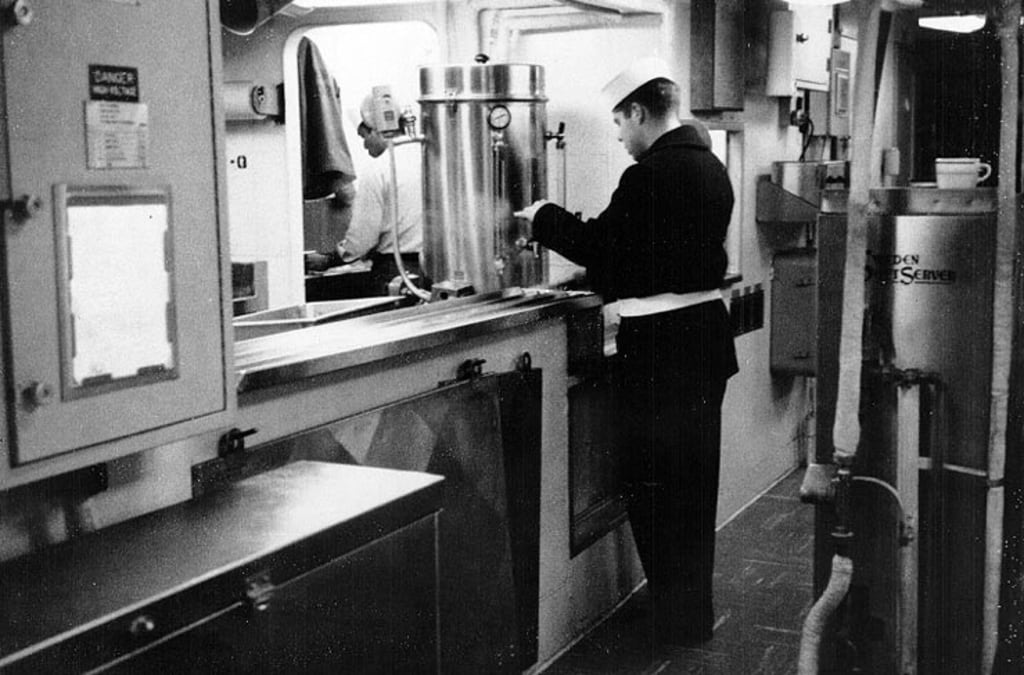
Officially, the ship was a research vessel designed for “oceanographic, electromagnetic and related research projects…to help the Navy and mankind toward the complete understanding of the oceans.”
It even carried two civilian researchers to conduct legitimate oceanographic tests. But the ship’s real mission was far more complicated. Pueblo was actually a spy ship, and her impending capture was another example in a long sequence of belligerent and seemingly reckless North Korean behavior that has remained all too familiar.
Throughout most of the Cold War, North Korea — or the Democratic People’s Republic of Korea, as it styles itself — followed a pattern of behavior that seemed to fly in the face of reason. The more the DPRK struggled internally and relied on outside assistance to survive, the more belligerent its behavior toward the outside world became.
In times of economic and political stability, the nation seemed willing to conform to accepted rules of international behavior, but at its weakest moments, it often struck out violently, even while begging the outside world for food or economic assistance. It represented, by American standards, the classic case of a surly dog biting the hand that feeds it.
By North Korean standards, however, such behavior made perfect sense. Premier Kim Il-sung had ruled the rigidly communist nation since its founding in 1948, and his hold on power was predicated on his promise to maintain the DPRK’s strength and independence. His carefully nurtured image as a demigod was predicated on his ability to guide his people toward a uniquely Korean form of prosperity and stability.
During times of domestic turmoil, the basis for Kim’s regime came into question when he could no longer conform to the image he had created. To compensate and distract — and to prove his mettle to the North Korean people — Kim often picked a fight with an alleged foreign threat.
The late 1960s were a time of intense internal stress for North Korea. A severe downturn in the latter half of the decade erased earlier economic achievements, industrial and agricultural production declined precipitously, and food and housing shortages were widespread.
In 1966 a visiting Romanian official reported that living conditions had “stagnated,” power shortages had significantly hindered industrial growth, and “indifference, passivity and distrust concerning the regime’s policies was observable in the population’s attitude.”
Political opposition emerged, culminating in a series of purges that left the Kim regime in its weakest position since assuming power. In the face of such circumstances, Kim did what he would do repeatedly over the next three decades—he launched an attack on the United States to remind North Koreans of his strength and brilliance.
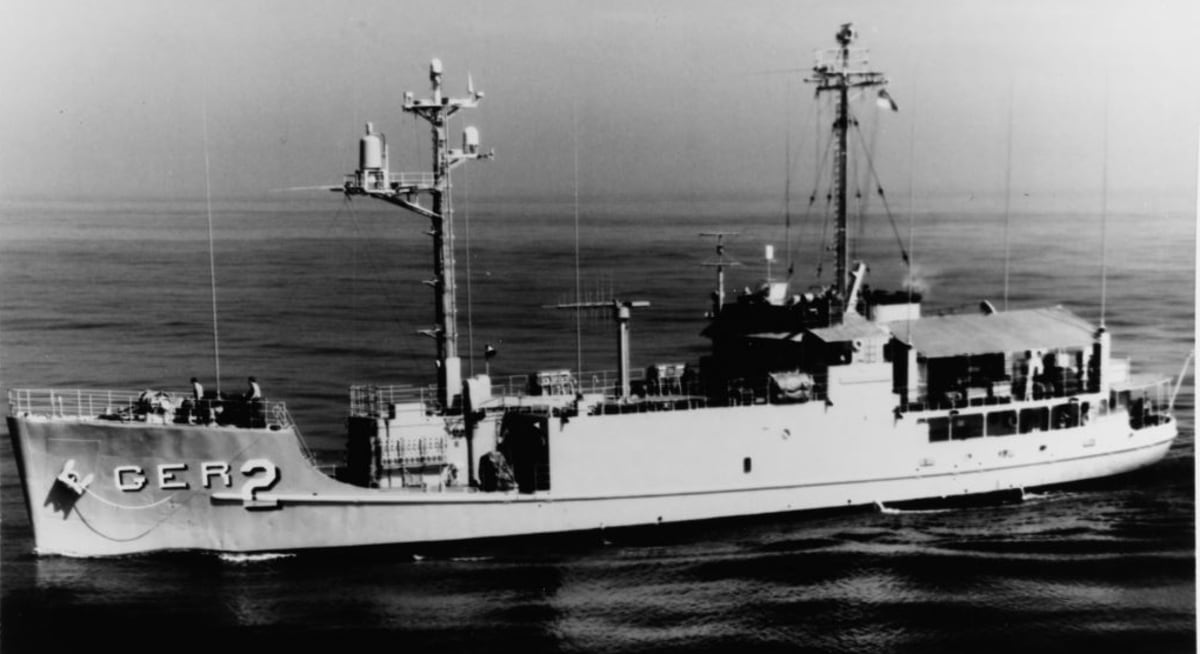
The men of the Pueblo, to put it simply, were not victims of the Cold War; they were victims of internal DPRK circumstances that rendered them vital propaganda pawns for one of the world’s most repressive dictators.
That danger at all was an unintended result of Operation Click Beetle.
Run jointly by the Navy and the National Security Agency, the project converted outdated light cargo ships into electronic intelligence gatherers that were then dispatched to the Sea of Japan to eavesdrop on America’s rivals. Pueblo was an ideal candidate for the program — launched in 1944 as the Army general cargo ship FP-344, it was a sturdy and dependable vessel. Transferred to the Navy in 1966, it was converted, redesignated AGER-2 and commissioned in May 1967.
On what was to be both its maiden voyage and its only mission as an electronic intelligence platform, Pueblo received its orders: 1) DETERMINE NATURE AND EXTENT OF NAVAL ACTIVITY IN VICINITY OF NORTH KOREA PORTS OF CHONGJIN, SONG JIN, MAYANG-DO AND WONSAN. 2) SAMPLE ELECTRONIC ENVIRONMENT OF EAST COAST NORTH KOREA, WITH EMPHASIS ON INTERCEPT/FIXING OF COASTAL RADARS. 3) INTERCEPT AND CONDUCT SURVEILLANCE OF SOVIET NAVAL UNITS OPERATING TSUSHIMA STRAIT.
The primary goal was to obtain details on the North Korean submarine fleet, thought to be stationed near Mayang-do; there was also some hope of encountering one of a new class of Soviet submarines believed to be operating along Korea’s east coast.
The Navy also ordered Pueblo to test North Korean and Soviet reaction to the ship’s presence, evaluate the ship’s overall intelligence-collection abilities, intercept various electronic signals on behalf of the National Security Agency, and monitor any communist actions that could be considered threatening to the United States.
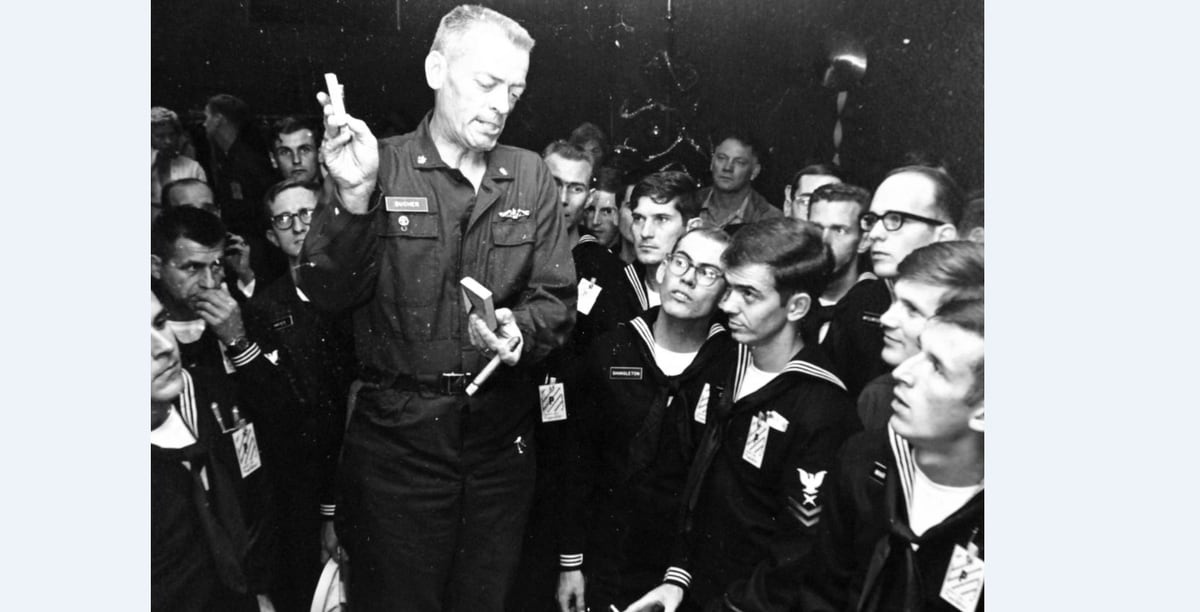
To avoid trouble, Cmdr. Lloyd “Pete” Bucher was ordered to remain at least 13 nautical miles from the coast and at least 200 yards from any Soviet vessel it might encounter, and to maintain electronic silence unless it made “firm contact” with enemy units.
It sounded like an exciting mission. For almost two weeks at sea, it was not. The eager crew quickly discovered that the DPRK coastline was quiet. The frigid weather conditions seemed to have discouraged much naval traffic. Pueblo had intercepted routine Morse code and voice transmissions, as well as signals from a number of radar stations the Navy already knew existed, but overall the intelligence collection was meager.
The communications technicians, Bucher later recalled, “were bored to death.”
Things began to change on the afternoon of Jan. 22, 1968. As Pueblo cruised just outside Wonsan, the starboard lookout reported the approach of two North Korean trawlers. In the pilothouse, the worried navigator called the executive officer.
“I’m not sure of our position,” he admitted, “and it would be most unfortunate if we got into that red area, and they came out and threw a line on us and said, ‘You’re our prisoners.’”
The DPRK ships, Soviet-built Lentra-class trawlers converted for military use, approached Pueblo, circling at a distance of less than 25 yards. North Korean soldiers glared at the Americans with clear hostility.
“They looked,” thought one sailor, “like they wanted to eat our livers.”
After a few laps, the trawlers suddenly sped toward Wonsan. Pueblo had been discovered. Still, there seemed little reason to panic: The ship did not display any overt signs of its nationality, the oceanographers had been conducting legitimate tests when the North Koreans arrived, and the ship was in international waters.
Besides, Bucher had been warned to expect routine harassment and ordered to demonstrate that the Americans could not be intimidated. Accordingly, he sent a radioman down to the communications center to inform the Navy of recent events, but planned no further response.
“No attempt made at surveillance/harassment,” the report concluded. “Intentions: Remain in present area.”
It was a reasonable decision. It was also one the crew would soon regret.
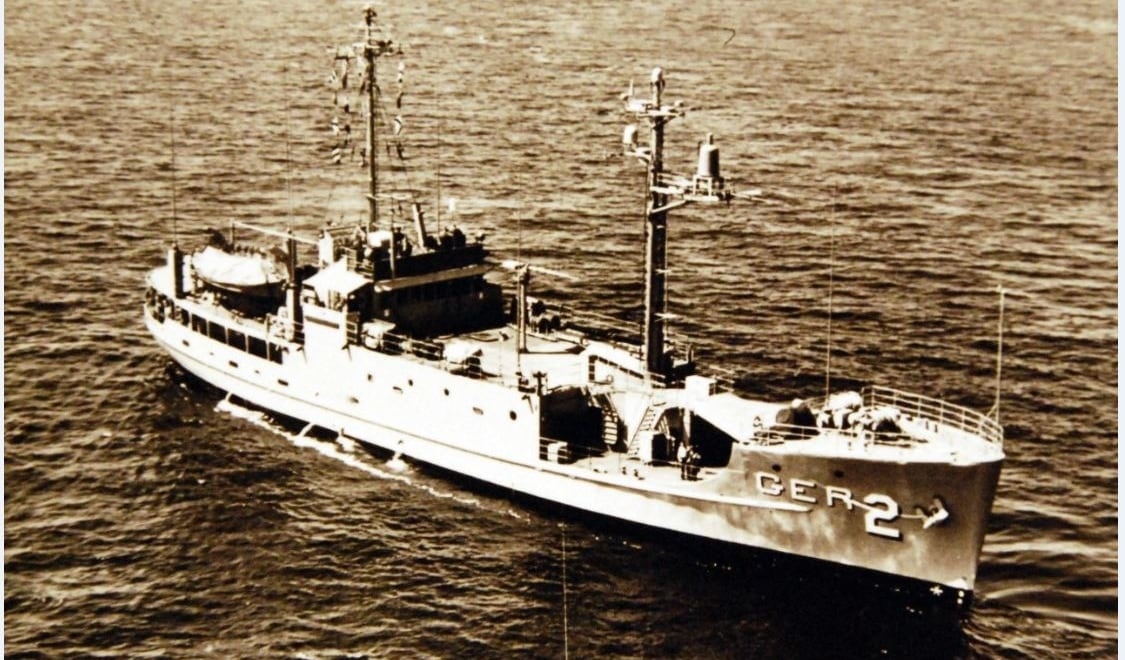
Pueblo remained off Wonsan the next day. At midday, a North Korean SO-1 subchaser suddenly appeared. Soon, three more DPRK ships arrived, all Soviet-built P-4 torpedo boats capable of exceeding 50 knots and carrying two 12.7mm machine guns and two 18-inch torpedo tubes; Pueblo could reach 13 knots and carried no significant means of self-defense.
The adversaries circled each other warily, and the SO-1 radioed an update to its base: “We have approached the target. I judge it to be a reconnaissance ship. It is Americans. It does not appear that there are weapons.”
The SO-1 then raised ominous signal flags: HEAVE TO OR I WILL OPEN FIRE.
Bucher ordered a position check and was gratified to find his vessel clearly in international waters, 15.8 nautical miles from the nearest North Korean territory.
Emboldened, he replied: I AM IN INTERNATIONAL WATERS. INTEND TO REMAIN IN THE AREA UNTIL TOMORROW.
The North Koreans ignored Bucher’s reply, and the situation quickly deteriorated as the roar of jet engines announced the arrival of two MiG fighters. In the distance, a second subchaser and a fourth torpedo boat approached from Wonsan.
At 1:06 p.m. the lead SO-1 again radioed its headquarters: “According to present instructions, we will close down the radio, tie up the personnel, tow it and enter port at Wonsan. At present we are on our way to boarding.”
Within 10 minutes a dozen armed soldiers from the DPRK’s 661st Unit hopped from the subchaser onto one of the torpedo boats, which then closed on Pueblo. The ship drew so near the Americans could hear the soldiers cocking their assault rifles.
As the torpedo boat closed to within five yards, Bucher’s voice rang out: “All ahead one-third.”
Pueblo’s engines slipped into gear, and the ship lurched toward the open sea.
Pulling away, Bucher raised a new flag: THANK YOU FOR YOUR CONSIDERATION, he signaled. AM DEPARTING THE AREA.
But it was not to be. The pursuers easily caught up with the dilapidated Pueblo and opened fire with 57mm cannon and machine guns.
Eight cannon shells penetrated the ship, leaving the superstructure damaged and leaking and a number of crewmen injured. Pueblo’s poor communication setup made it almost impossible to get guidance or help from COMNAVFORJAPAN (Commander, U.S. Naval Forces Japan), which was supposedly overseeing the operation.
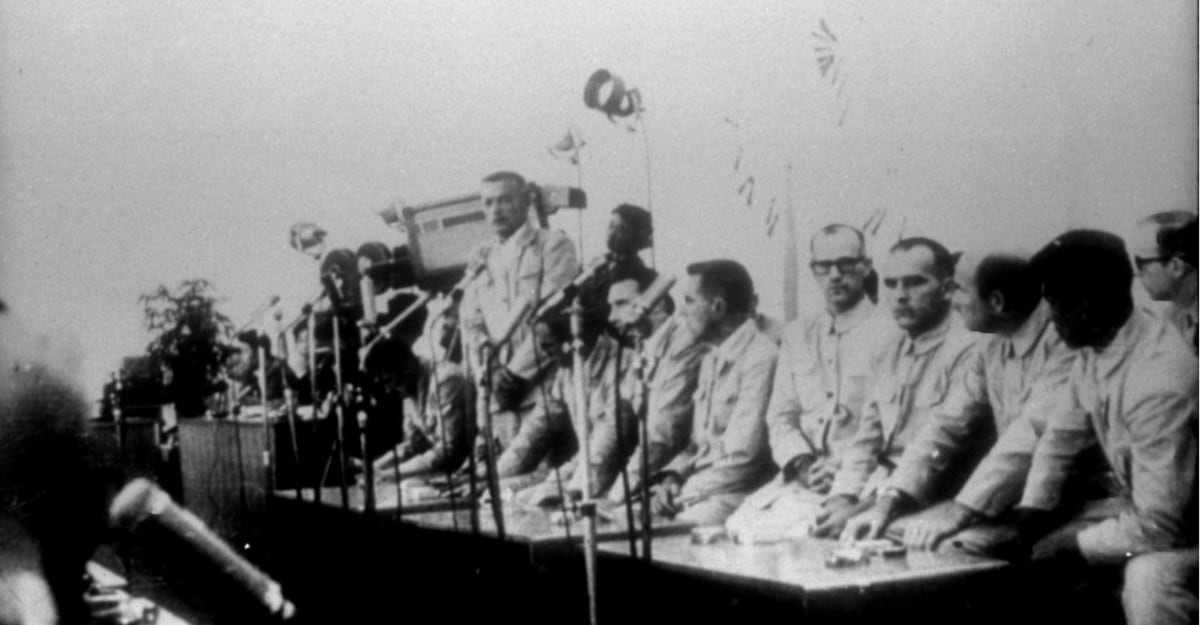
Bucher ordered the emergency destruction of classified materials, and smoke and heat soon filled the ship.
At the helm, Boatswain’s Mate 2nd Class Ronald Berens yelled, “Jesus Christ! I’ll take Vietnam over this.”
Recognizing that escape was futile and resistance impossible, Bucher ordered the ship stopped. Pueblo’s mission was over.
The shooting quickly ended, and the lead subchaser raised a new signal: FOLLOW IN MY WAKE—I HAVE PILOT ABOARD.
Bucher ordered the ship to comply, and Pueblo turned east, following the subchaser at 5 knots. Below deck, Communication Technician Don Bailey kept COMNAVFORJAPAN apprised over a teletype line.
WE ARE BEING ESCORTED INTO PROB WONSAN REPEAT WONSAN, he sent at 1:45. ARE YOU SENDING ASSISTANCE?
The answer was only slightly encouraging: WORD HAS GONE OUT TO ALL AUTHORITIES.
As they headed into North Korean waters, Bucher took a quick tour of his ship. The remaining amount of classified materials was horrifying. Desperate, he decided to gamble. He ordered the ship stopped, hoping to feign a mechanical breakdown and buy more time for destruction.
The leading subchaser quickly turned and opened fire. The torpedo boats joined in, raking Pueblo with machine-gun fire from as close as 100 yards. Injuries were numerous, one of them particularly serious.
Fireman Duane Hodges was carrying a bag of classified documents to the starboard deck when a shell tore off his right leg; he would die within an hour.
Bucher ordered the engines restarted, but before they could make headway, a torpedo boat backed down on Pueblo, throwing a line onto the deck. Ten DPRK soldiers followed, leaping aboard with weapons drawn and bayonets fixed. A second group quickly followed.
Pueblo was officially in enemy hands.
Don Bailey sent a final message: FOUR MEN INJURED AND ONE CRITICALLY AND GOING OFF THE AIR NOW AND DESTROYING THIS GEAR. It was 2:33 p.m.
The North Koreans took Pueblo to the naval yard at Chojikan, near Wonsan, where it soon became a floating DPRK propaganda museum.
It served another function as well, providing the communist bloc with a trove of intelligence information. Shortly after the seizure, a North Korean aircraft flew to Moscow carrying almost 1,000 pounds of cargo salvaged from Pueblo.
Among the many items lost were a detailed account of top-secret American intelligence objectives for the Pacific; classified U.S. communications manuals; a number of vital NSA machines and the manuals that detailed their operation and repair; the NSA’s Electronic Order of Battle for the Far East; information on American electronic countermeasures; radar classification instructions; and various secret codes and Navy transmission procedures.
Little wonder, then, that an NSA report described the loss as “a major intelligence coup without parallel in modern history.”
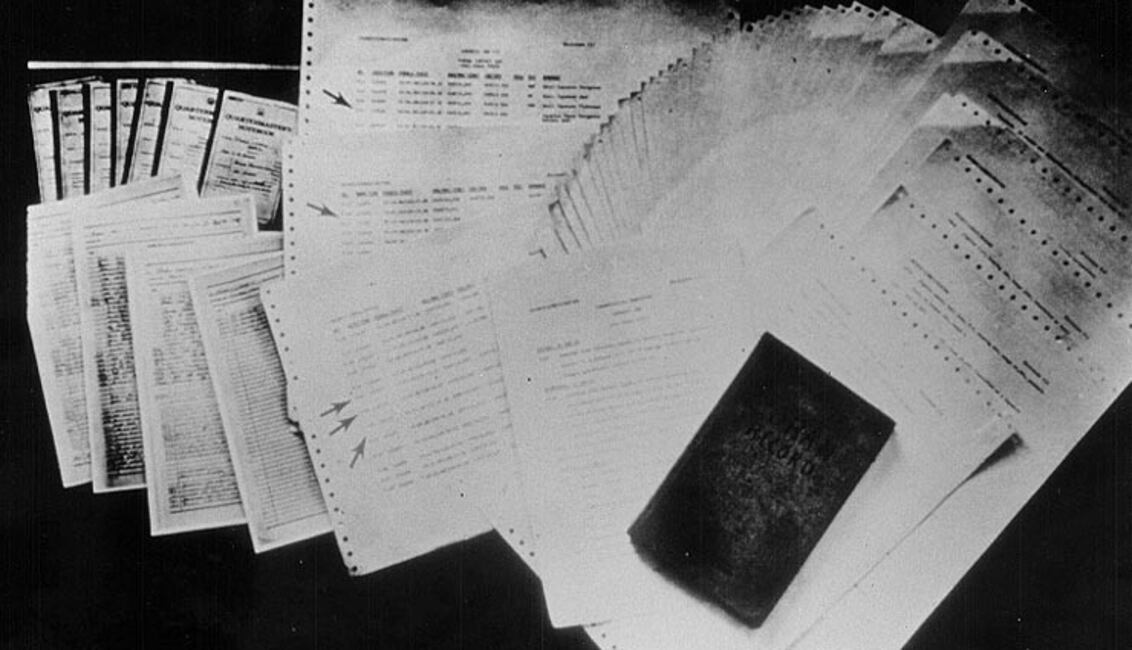
Still, for the men of Pueblo, the intelligence damage paled before the more immediate task of trying to survive.
Upon landing in Wonsan, the men were blindfolded, dragged off the ship and taken to the first of two DPRK prison camps they would call home during their year of captivity. Within days their captors began a relentless regimen of torture, starting with the officers and working down through the ranks.
The men resisted, but eventually all provided the North Koreans what they wanted: confessions and letters of repentance the DPRK then used for domestic propaganda.
Bucher endured 36 hours of torture and deprivation, only yielding when they threatened to shoot the youngest crewman before his eyes.
He agreed to sign a DPRK-provided letter of confession that read, in part, “I say frankly that our act was a criminal act, which flagrantly violated the armistice agreement, and it was a sheer act of aggression.…It is the greatest desire of myself and my crew that we will be forgiven leniently by the government of the Democratic People’s Republic of Korea.”
The other men soon followed the same path. Many tried to resist, but the physical brutality simply overwhelmed them. Despite their overt compliance, the men retained sparks of resistance, and as the months wore on, they filled their confessions with ridiculous details and twisted language intended to signal the coerced nature of their statements.
In one confession, they claimed to have been trained by Buz Sawyer and given orders by Fleet General Barney Google and intelligence operative Sol Loxfinger; if their mission failed, Google warned, Don Ho would likely give them the dreaded tiny bubbles treatment.
While Pueblo’s crew suffered, talks for their release offered little reason for optimism.
When news of the seizure first reached the United States, many demanded retribution. The commander in chief of the U.S. Pacific Fleet recommended sending a destroyer into Wonsan to do “whatever was necessary” to retrieve the ship and crew, and the American commander of United Nations forces in Korea suggested giving the DPRK a nuclear ultimatum.
Telegrams demanding nuclear retaliation flooded the White House. But the administration of President Lyndon Johnson resolved that diplomacy was the order of the day. The lives of the crew were an important factor in this decision, as any retaliation or rescue attempt would likely have resulted in their immediate execution.
But other factors also steered Washington toward diplomacy. The growing demands of the Vietnam War made the prospect of opening a second front particularly unpalatable, and the risk of armed conflict with the Soviet Union or China was almost unthinkable.
Even a quick retaliatory strike risked a DPRK attack across the 38th parallel with potentially devastating consequences. The price struck Secretary of Defense designee Clark Clifford as too steep.
“I am deeply sorry about the ship and the 83 men,” he told the president, “but I do not think it is worth a resumption of the Korean War.”
A diplomatic resolution, however, proved hard to reach. At the insistence of the DPRK, negotiations began at the Military Armistice Commission (MAC) in Panmunjom.
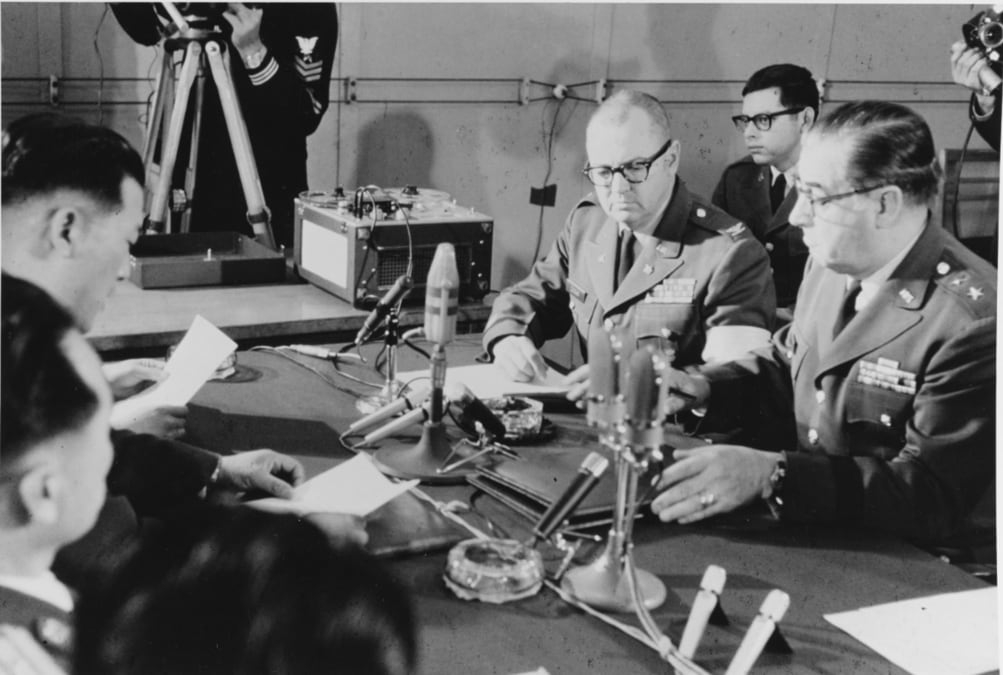
Talks began on February 2 in an atmosphere that was hardly promising. DPRK Maj. Gen. Pak Chung Kuk rejected claims of America’s innocence, calling the mission “the most flagrant violation of the armistice agreement” and describing the crewmen as “aggressors and criminals.”
Two weeks later he submitted the DPRK terms for resolution: The men would be released only when the Johnson administration “apologizes for the fact that the U.S. government dispatched the armed spy ship Pueblo to the territorial waters of the Democratic People’s Republic of Korea, conducted espionage activities and perpetrated hostile acts, assuring that it will not commit such criminal acts again.”
Johnson rejected the terms, and American negotiators spent much of the year making counteroffers, but North Korea refused to budge.
United Nations Ambassador Arthur Goldberg summed up the administration’s attitude in a telegram to the president in late February; “I see no alternative,” he lamented, “to painstakingly continuing discussions on the hope that we can wear the North Koreans down before they wear us down. It is better to Jaw-Jaw than War-War.”
Recently released materials from the communist bloc indicate American officials never fully understood what had transpired. When news of Pueblo’s seizure hit Washington, D.C., top officials assumed the Soviet Union lay behind it.
After the Soviets indicated through back channels they had not been involved, many looked elsewhere for a communist master hand at work. Some believed they found it in Vietnam, especially given the launch of the Tet Offensive a week after the seizure.
We now know, however, that in this incident — as in many others from the period — North Korea had acted unilaterally, and the Soviets were actually very unhappy about the attack.
By publicly blasting the USSR, however, the Johnson administration had not helped matters. The Soviets were reportedly doing all they could behind the scenes to end the crisis peacefully, but worried their communist allies would perceive such diplomacy as a response to American pressure.
Putting them in this position, lamented a Soviet official, had been a “tactical blunder.”
Still, evidence suggests they continued to push the DPRK to moderate its demands. It also suggests they had no impact; North Korea would not release the men until the United States met its demands.

A resolution came from an unlikely source.
In November 1968, the State Department’s country director for Korea discussed the standoff with his wife, admitting that he saw no alternative to signing the apology letter, but wondered how to minimize American humiliation in doing so. She offered a suggestion: Agree to sign the letter only if North Korea allowed the United States to repudiate it publicly just before signing.
The chief American negotiator, Maj. Gen. Gilbert Woodward, loved the idea.
“I said right then and there,” he remembered, “‘They’ll buy it.’…It satisfied their one condition, a signature on a piece of paper.…The North Korean people would never hear about that repudiation. Their propaganda boys would take care of that. As for the rest of the world, well, they just didn’t care.”
Woodward was right. Throughout the negotiations, American officials believed North Korea had acted for larger reasons tied to the Cold War, that Kim had captured the ship to somehow advance the international communist conspiracy. Accordingly, they had not considered solutions like this, which offered little benefit to the international movement but provided Kim with coveted domestic propaganda.
In short, Kim wanted only the symbolic value of the American humiliation for display to the people of his own country.
On December 17, negotiators met to discuss Pueblo for the 26th time. Woodward presented the new plan as the final option, the last chance for a resolution before the crisis fell to the incoming Nixon administration.
After a 50-minute recess, Pak returned to the conference room. “An agreement has now been reached,” he announced.
The impasse had been broken.
On December 22, the Pueblo crewmen were summoned to a large room in their prison by the colonel in charge of their captivity, a man whose brutality would remain with them for the rest of their lives. This time, however, he was smiling.
“As I knew and told you from the beginning of this shameful imperialist intrigue against our peace-loving Korean people,” he announced proudly, “it has ended with the warmongering U.S. on its knees apologizing to us and assuring that no such provocation and many intrusions into our sovereign territorial waters shall occur again.”
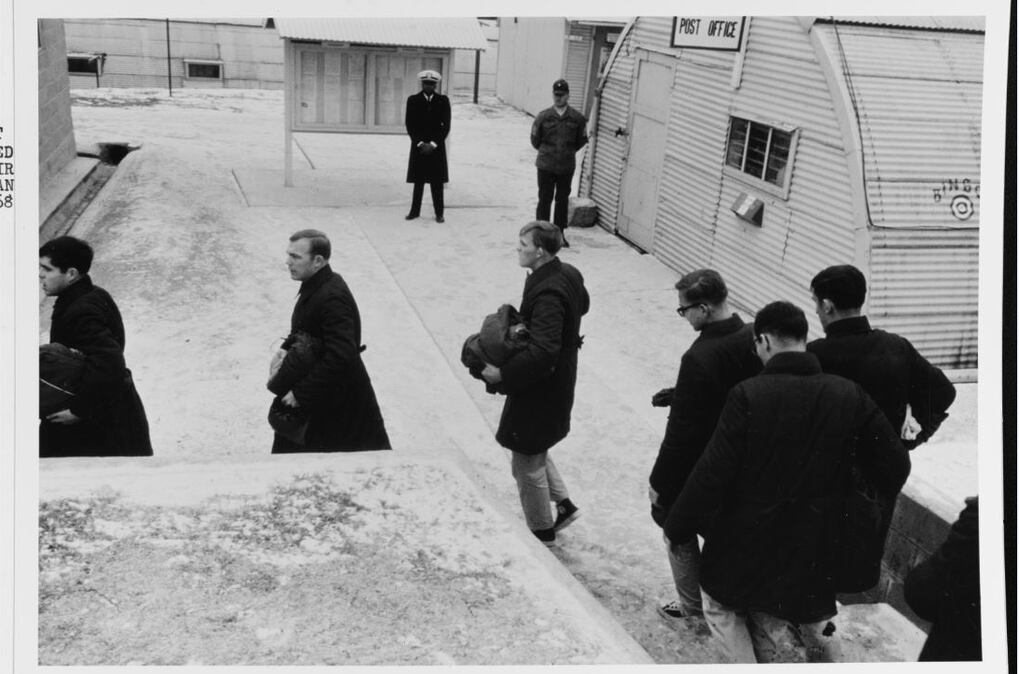
On Dec. 23, 1968, the crewmen arrived by bus at the northern end of the “Bridge of No Return” in the demilitarized zone separating North and South Korea.
Before they arrived, Woodward wholly repudiated the statement North Korea demanded for their release, then turned and signed the letter.
A few hours later, the captured Americans were taken from their bus and brought to the end of the bridge. A North Korean soldier approached at 11:30 a.m. and grabbed Bucher.
“Now walk across that bridge, captain,” he ordered. “Not stop. Not look back. Not make any bad move. Just walk across sincerely. Go now!”
Fighting the urge to run, Bucher slowly began his march home while North Korean loudspeakers blasted a tape of his confession in the background. After crossing, he turned to face the bridge and identify his men as they crossed in 30-second intervals.
The first to follow Bucher was Duane Hodges, transported across the bridge in a plain wooden coffin. As each man reached the end, Bucher loudly pronounced his name and greeted him with a handshake and a smile.
“It’s just like,” one announced on reaching the American side, “climbing out of hell into heaven.”
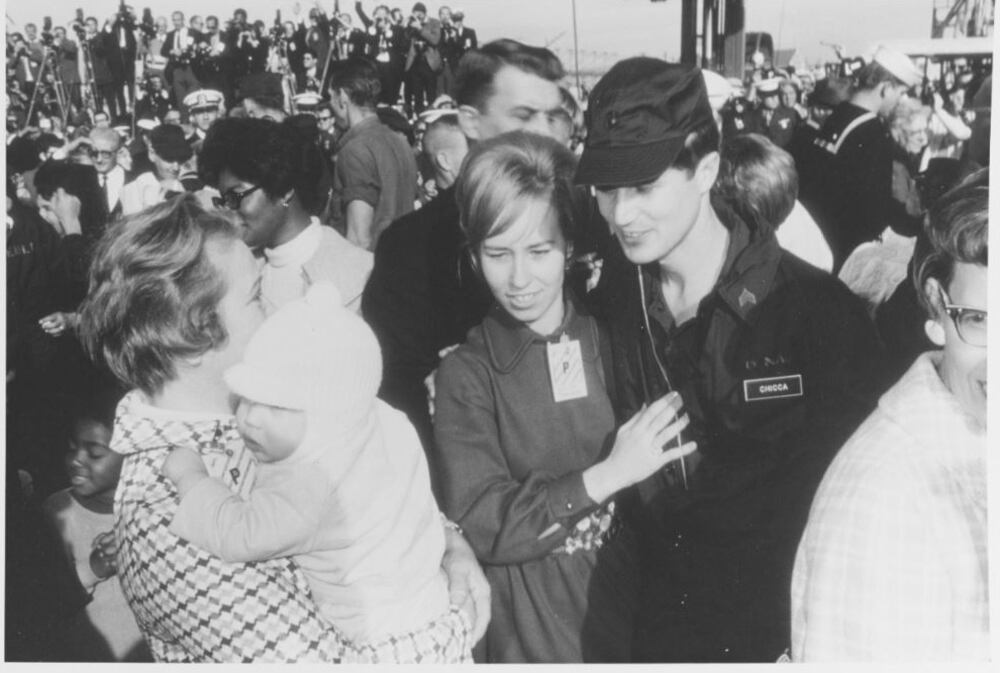
The men returned to the United States in time to spend Christmas with their families. Yet, despite the jubilation that greeted them when they landed in San Diego, their ordeal was not finished.
On December 24, the commander of the U.S. Pacific Fleet announced the formation of a formal court of inquiry to investigate the circumstances of the seizure and captivity. Hearings lasted two months and produced more than 4,300 pages of testimony.
The final report recommended courts-martial for Bucher and his executive officer, Lt. Edward R. Murphy, and noted that “with few exceptions, the performance of the men was unimpressive.”
Although Secretary of the Navy John Chaffee overruled the recommendation, many in the armed forces continued to treat the men with contempt for surrendering and cooperating with their captors. Nor could the crew escape the physical and emotional impact of their imprisonment.
Most suffered through decades of physical pain, including loss of feeling in their extremities, vision problems and various forms of nerve damage. A large number could not hold steady jobs because of their physical disabilities.
Most found even greater problems adjusting emotionally. Divorce, alcoholism, drug abuse and suicide took a toll.
To this day, many crewmen battle disabilities they cannot overcome, feelings they cannot hold back and memories they can never escape.
“The second they opened fire on us,” recalled Seaman Stu Russell, “the whole world changed completely and forever.”
The Pueblo incident, like the Korean War before it, was never fully resolved. As for the ship itself, it remains in North Korean hands, anchored in Pyongyang as a floating propaganda tool.

For further reading, Mitch Lerner recommends his own The Pueblo Incident: A Spy Ship and the Failure of American Foreign Policy; A Matter of Accountability: The True Story of the Pueblo Affair, by Trevor Armbrister; and Flash Point North Korea: The Pueblo and EC-121 Crises, by Richard A. Mobley.
This piece was originally published in the March 2010 issue of Military History, one of Navy Times' sister magazines. To subscribe, click here.




